Are you tired of constantly replanting flowers in your garden?
What if you could enjoy vibrant blooms all season long with minimal upkeep?
We understand the desire for a beautiful, thriving garden without the hassle.
That’s why we’re excited to share with you our list of longest-lasting flowers that will keep your garden looking its best.
Having garden flowers that bloom for extended periods can transform your outdoor space.
It becomes a haven for both you and local wildlife.
In this blog post, we will explore the top flowers for your garden that are sure to impress.
By the end of this article, you will know which longest-lasting flowers are perfect for your garden.
This will help you make informed decisions for a stunning outdoor display.
Why Choose Long-Lasting Flowers for Your Garden
Adding long-lasting flowers to your garden keeps it lively all season.
They make your outdoor space beautiful and save you from replanting often.
This is great for those who don’t have a lot of time to garden.
Benefits of Extended Blooming Periods
Long-lasting flowers bloom for a long time.
This means your garden stays colorful and interesting with little upkeep.
| Flower Type | Blooming Period | Maintenance Level |
|---|---|---|
| Marigolds | 8 weeks | Low |
| Zinnias | 12 weeks | Medium |
| Petunias | 16 weeks | Medium |
Bloom Cycles and Planning
To make your garden look its best, know the bloom cycles of different flowers.
Pick a mix of flowers that bloom at different times. This way, your garden will change and stay interesting all season.
Seasonal Combinations for Year-Round Color
To have year-round color in your garden, plan carefully and choose the right flowers.
Mix flowers that bloom in different seasons.
For example, start with spring bulbs, then add summer flowers, and finish with fall bloomers.
This keeps your garden colorful all year.
1. Marigolds – The Reliable Summer Staple
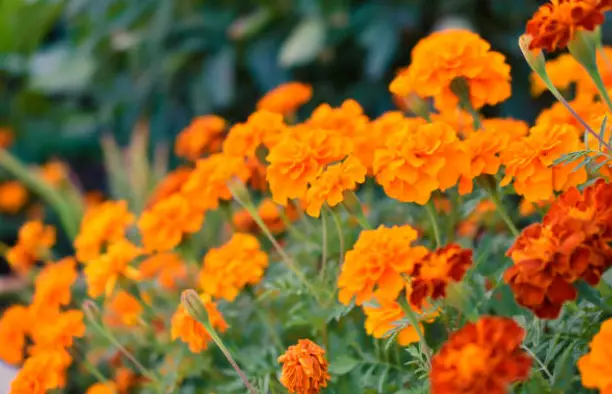
Summer gardens are bright with marigolds, known for their long-lasting blooms and easy care.
These vibrant flowers add color that lasts all summer.
Varieties and Color Options
Marigolds come in many colors, like oranges, yellows, and reds.
There are African marigolds and French marigolds, each with unique blooms and growth.
African marigolds have big, bright flowers, while French marigolds are smaller and more compact.
Planting and Care Requirements
Marigolds need full sun and well-draining soil to thrive.
Plant them in late spring, after the last frost. Regular watering and occasional fertilization help them grow well.
Pest-Repelling Benefits
Marigolds are great at keeping pests away.
They repel nematodes, whiteflies, and other harmful insects, making them a good choice for gardens.
Common Problems and Solutions
Marigolds are mostly easy to care for but can face issues like powdery mildew and root rot.
Good air circulation and avoiding too much water can prevent these problems.
Marigold Quick Reference Table
| Aspect | Details |
|---|---|
| Sunlight | Full Sun |
| Soil | Well-draining |
| Watering | Regular |
| Pest Repelling | Nematodes, Whiteflies |
2. Black-Eyed Susans – Perennial Powerhouses
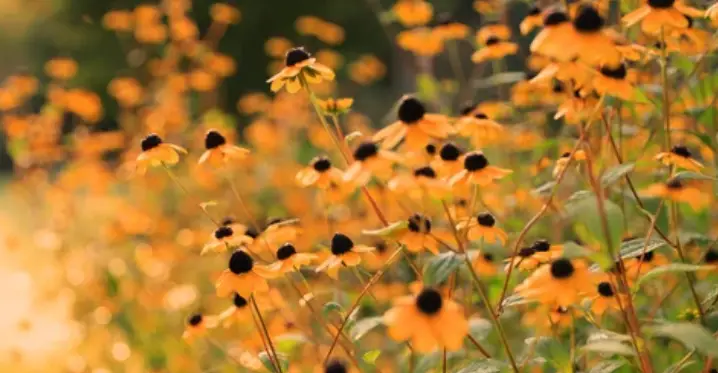
Planting Black-Eyed Susans
Black-Eyed Susans are a top choice for gardens. They add lasting color and beauty.
These flowers are stunning, robust, and easy to care for.
Native Habitat and 8-Week Bloom Cycle
Black-Eyed Susans grow in North America’s open woods and dry prairies.
They bloom for 8 weeks, showing off yellow petals with dark centers from mid-summer to early fall.
Maintenance Tips for Maximum Blooms
For the best blooms, they need full sun and well-drained soil.
Regular watering is key, but avoid overwatering.
Deadheading spent flowers helps them bloom more and look better.
Companion Planting Suggestions
Black-Eyed Susans go well with coneflowers and bee balm.
They also look great with annuals like zinnias and cosmos.
This mix creates a strong and beautiful garden.
Dealing with Common Diseases
Black-Eyed Susans can get diseases like powdery mildew and leaf spot.
Good air circulation and removing sick leaves help.
If it gets worse, you might need fungicides.
Black-Eyed Susan Quick Reference Table
| Characteristic | Description | Benefit |
|---|---|---|
| Bloom Cycle | 8 weeks | Long-lasting color |
| Native Habitat | North America | Adaptable to local climates |
| Maintenance | Low | Easy to care for |
| Companion Plants | Coneflowers, Bee Balm | Diverse garden ecosystem |
3. Geraniums – Versatile Bloomers for Months of Color
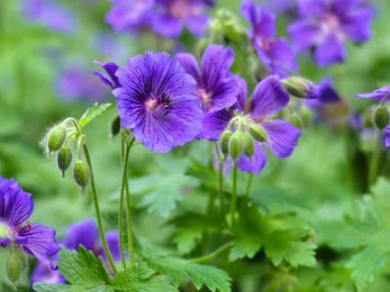
Geraniums are a gardener’s dream, providing vibrant color for months with little care.
They come in many colors and grow well indoors and outdoors.
Indoor vs. Outdoor Varieties
Geraniums fit different settings.
Indoor varieties brighten up your home.
Outdoor varieties handle various weather. Pick the right type for your space.
Deadheading for Continuous Flowering
Deadheading is key for endless blooms.
It tells the plant to keep flowering, keeping your garden colorful.
Overwintering Techniques
In cold areas, geraniums need winter care.
Bring them inside or store tubers in a cool, dry spot to keep them alive till spring.
Troubleshooting Yellow Leaves and Sparse Blooms
Yellow leaves and few blooms might mean too much or too little water, or not enough nutrients.
Changing how you care for them can fix these problems.
Geranium Quick Reference Table
| Care Aspect | Indoor Geraniums | Outdoor Geraniums |
|---|---|---|
| Lighting | Bright, indirect light | Full sun to partial shade |
| Watering | Water when top inch of soil is dry | Water deeply, allowing soil to dry slightly between waterings |
| Fertilization | Fertilize monthly during growing season | Fertilize every 2 weeks during growing season |
4. Zinnias – Heat-Loving Flowers That Keep Going
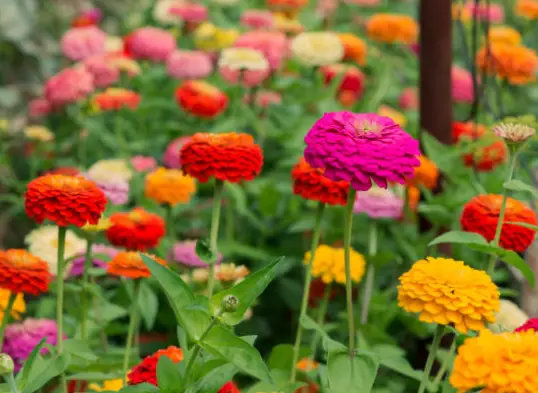
Zinnias add energy to any garden with their long-lasting blooms.
These vibrant flowers are a joy to see.
They also attract beneficial insects and pollinators.
From Seed to 12 Weeks of Spectacular Blooms
Zinnias are easy to grow from seed.
They’re perfect for gardeners of all levels.
By sowing seeds every few weeks, you get continuous blooms all summer.
With the right care, zinnias can bloom for up to 12 weeks.
This gives you a long display of color.
Cutting Practices to Encourage More Flowers
Regular cutting encourages more blooms.
Cutting zinnia flowers for arrangements tells the plant to make more. This keeps your garden looking fresh and vibrant.
Butterfly and Pollinator Attraction
Zinnias attract butterflies and pollinators. They’re great for any garden. Planting zinnias welcomes these beneficial creatures.
Preventing Powdery Mildew
To stop powdery mildew, make sure plants have good air. Water at the base, not overhead. This helps prevent the issue.
Zinnia Quick Reference Table
| Characteristic | Description | Benefit |
|---|---|---|
| Bloom Duration | Up to 12 weeks | Long-lasting color |
| Pollinator Attraction | High | Attracts butterflies and bees |
| Maintenance | Low | Easy to care for |
5. Coreopsis – The 10 Longest-Lasting Flowers Champion
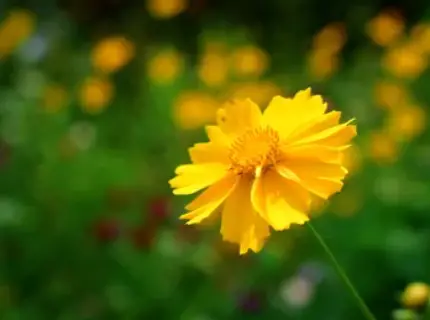
Coreopsis is a top pick for long-lasting flowers in your garden.
It’s known for its bright colors and lasting beauty.
This plant thrives in many conditions, making it perfect for those who want lasting garden beauty.
Perennial vs. Annual Varieties
Coreopsis has both perennial and annual types. Perennial Coreopsis comes back every year, adding color consistently.
Annual types offer more flexibility in garden design.
We can pick based on our garden’s needs and our taste.
Drought Tolerance and 16-Week Bloom Time
Coreopsis is great because it can handle dry spells well.
It also blooms for 16 weeks, giving us long-lasting flowers.
This makes it perfect for those who want easy, beautiful blooms.
Dividing and Propagating Tips
To keep Coreopsis healthy, we need to divide and propagate it.
This means digging it up, separating the roots, and replanting. It helps keep the plant strong and encourages new growth.
Managing Crown Rot and Other Issues
Coreopsis is mostly hardy but can get crown rot and other problems.
Good drainage and not overwatering help prevent these.
Regular checks and care are essential for a healthy Coreopsis.
Coreopsis Quick Reference Table
| Characteristic | Description |
|---|---|
| Bloom Time | 16 weeks |
| Drought Tolerance | High |
| Variety Types | Perennial and Annual |
6. Petunias – Cascading Color All Season Long

Petunias are a gardener’s dream, bringing cascading color to any outdoor spot. They are easy to care for and bloom for a long time.
This makes them a favorite in our gardens.
Wave vs. Traditional Varieties
Petunias come in two types: Wave and traditional.
Wave petunias spread out, perfect for hanging baskets.
They cascade beautifully. Traditional petunias grow upright, great for garden beds and containers.
Container and Hanging Basket Success
For petunias in containers, use a mix that drains well.
Make sure containers have holes for water to flow out.
They love full sun, so pick a spot with at least 6 hours of direct sunlight.
Fertilizing for Continuous Blooms
Fertilizing is key for petunias to keep blooming. Use a balanced fertilizer (20-20-20) once a week. Add a bloom booster (15-30-15) every other week for more flowers.
Reviving Leggy Plants Mid-Season
If petunias get leggy, just cut them back by a third. This will help them grow bushy and bloom more. Remember to fertilize after cutting to help them recover and bloom again.
Petunia Quick Reference Table
| Care Aspect | Recommendation | Frequency |
|---|---|---|
| Watering | Keep soil consistently moist | Daily during hot weather |
| Fertilizing | Balanced, water-soluble fertilizer | Weekly |
| Pruning | Cut back leggy stems | As needed |
7. Cosmos – Self-Seeding Beauties
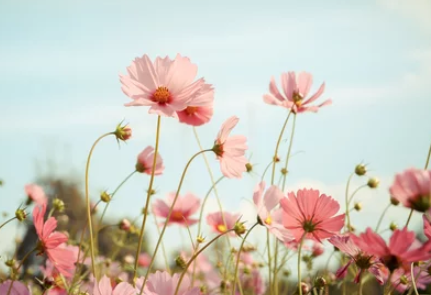
Cosmos flowers are a gardener’s dream.
They offer vibrant colors and are easy to care for.
We love adding them to our gardens because they look stunning and need little work.
Low-Maintenance Appeal
Cosmos are hardy and easy to care for.
They prefer well-drained soil and full sun.
This makes them great for sunny spots.
Their low-maintenance nature is very appealing, letting us enjoy their beauty without stress.
Height and Spacing Considerations
When planting cosmos, think about their height and spacing.
Taller varieties can grow up to 6 feet tall. Dwarf varieties stay around 2 feet. Plant them 12-18 inches apart for good air flow.
Extending the 10-Week Bloom Season
To keep cosmos blooming, plant new seeds every few weeks.
This way, you get blooms all summer.
Also, deadheading spent flowers helps them bloom more and not waste energy on seeds.
Staking Tall Varieties in Windy Areas
In windy areas, tall cosmos need staking.
We use bamboo stakes or twine to keep them upright. This way, they can keep blooming without falling over.
Cosmos Quick Reference Table
| Characteristic | Description |
|---|---|
| Sunlight | Full Sun |
| Soil | Well-drained |
| Height | 2-6 feet |
| Bloom Season | 10 weeks |
8. Lantana – Heat and Drought-Resistant Bloomers

Lantana flowers are clusters of small blooms that add color and are very tough.
They are great for gardens that need longest-lasting flowers and can handle tough weather.
Color-Changing Flower Clusters
Lantana’s flower clusters change colors.
They start yellow or pink and turn orange, red, or purple.
This makes Lantana a fascinating addition to any garden.
Growing in Different Climate Zones
Lantana loves warm weather, best in USDA zones 9-11.
But, it can grow in other zones too.
For example, in containers that can go inside when it’s cold. It’s a drought-resistant plant, perfect for dry areas.
Pruning for Shape and 20+ Weeks of Flowers
Pruning Lantana keeps it looking good and blooming.
Cutting off old flowers helps it grow new ones. This way, you get heat-resistant flowers for over 20 weeks.
Managing Lantana in Invasive-Prone Areas
In some places, Lantana can spread too much.
To stop this, watch how it grows, pull out seed heads, and use special kinds that don’t spread.
This keeps your garden looking good without the plant getting out of control.
Lantana Quick Reference Table
| Characteristic | Description |
|---|---|
| Bloom Period | 20+ weeks |
| Climate Preference | Warm, USDA zones 9-11 |
| Maintenance | Regular pruning |
9. Calibrachoa (Million Bells) – Tiny Flowers with Big Impact

Calibrachoa, or million bells, has small, bell-shaped flowers.
It’s easy to care for and adds a lot of color to any garden.
Its vibrant blooms cascade and last for months.
Container Growing Techniques
Calibrachoa does well in containers, hanging baskets, and window boxes.
Use a potting mix that drains well and a container that’s 6-8 inches deep.
This helps the roots grow and keeps the soil from getting too wet.
Soil and Water Requirements
It likes slightly acidic to neutral soil pH (around 6.0-7.0) and consistent moisture.
Water it when the top inch of soil feels dry. Avoid too much water to prevent root rot.
Combining with Other Long-Lasting Flowers
Calibrachoa looks great with flowers like petunias, verbena, and lantana. Mixing these in containers creates a lively display that changes with the seasons.
Fixing Yellowing and Bloom Decline
If calibrachoa turns yellow or stops blooming, it might be due to too much or too little water, or not enough nutrients. We fix this by checking the soil, fertilizing regularly, and trimming back long stems to encourage new growth.
Calibrachoa Quick Reference Table
| Characteristic | Detail |
|---|---|
| Bloom Duration | May to Frost |
| Preferred Soil pH | 6.0-7.0 |
| Watering Needs | Consistent Moisture |
| Fertilization | Regular, Balanced Fertilizer |
10. Verbena – Long-Blooming Ground Cover and Beyond

Verbena is a top pick for long-lasting flowers in your garden.
It’s not just a ground cover; it also brings vibrant colors to your garden.
Spreading vs. Upright Varieties
Verbena has both spreading and upright types.
Spreading varieties are great for filling gaps or covering containers.
On the other hand, upright varieties add height and structure to your garden.
Sun and Soil Preferences
Verbena loves full sun and well-draining soil.
It can handle some shade, but it blooms best in the sun.
For the best results, make sure the soil drains well to avoid root rot.
Maintaining 12-16 Weeks of Continuous Blooms
To keep verbena blooming, remove dead flowers regularly. Also, use a balanced fertilizer every month to help it grow and flower well.
Winter Protection in Colder Climates
In cold areas, verbena needs protection during winter. Mulching or bringing potted plants inside can help it make it through until spring.
Verbena Quick Reference Table
| Variety | Sun Preference | Bloom Period |
|---|---|---|
| Spreading | Full Sun | 12-16 weeks |
| Upright | Full Sun to Partial Shade | 12-16 weeks |
Conclusion
By adding the 10 longest-lasting flowers to our garden, we can have blooms all year.
Good garden planning is key to a colorful and lively garden.
We’ve looked at many flowers, like Marigolds and Verbena, which bloom for a long time.
Mixing these flowers makes our garden exciting and ever-changing.
To keep our garden blooming, we need to know how to care for each flower.
This includes sunlight, soil, and water needs.
With the right care, our garden will stay vibrant and lively.
Using these tips and adding the 10 longest-lasting flowers, we can have a stunning garden all year.
It will be a place of beauty and life.




